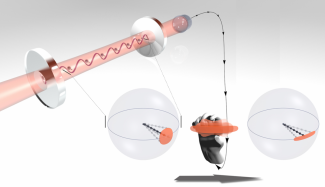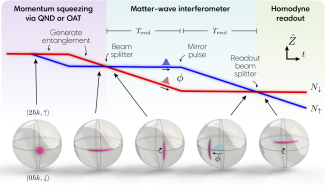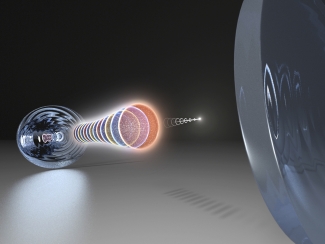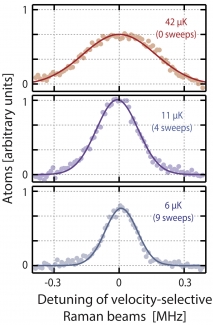We laser cool rubidium atoms to microKelvin temperatures and trap them using optical lattices inside of a high finesse cavity. The high finesse cavity allows the light to interact with the atoms many times to create strong collective coupling between an ensemble of nearly a million atoms and optical modes of the cavity. Learn more below about our research including:
- Highly-entangled states using quantum non-demolition measurements and cavity-mediated interactions
- The first entanglement-enhanced matterwave interferometer
- XYZ Hamiltonian engineering
- Gluing matterwave packets together with light
- Superradiant lasers with < 1 photon inside the cavity
- Novel magnetometers
- Novel laser cooling
Entangled Spin Squeezed States via Quantum Nondemolition Measurements
Quantum metrology with atoms is extremely powerful because the laws of quantum mechanics provides a quantum certainty that atoms of a given type are identical. This allows us to build sensors of time, magnetic and electric fields, accelerations, and rotations, and apply these sensors to search for new physics. However, the price we pay for this quantum certainty, is that the measurement precision is limited by quantum uncertainty principles that we are more familiar with and in this context referred to as the Standard Quantum Limit. By entangling the atoms, one can create states in which the atoms conspire together to partially cancel each atom's quantum noise. One example of this is a spin squeezed state in which the orientation of a collection of spins in a real or pseudo space has angular uncertainty in its orientation that can be squeezed in one direction at the expense of noise in another angular direction that does not impact your experiment.
We utilize the quantum measurement process to create some of the largest amounts of entanglement every directly detected, surpassing the Standard Quantum Limit on phase estimation by a factor of 60 or about 18 dB. This collective or quantum nondemolition (QND) measurement approach is very powerful. With only a 50 microsecond measurement pulse of light, we can create a state with measurement sensitivity equivalent to that of 10,000 perfect copies of 60 atom perfect cat states. Such states are well out of range of any current microscopic approaches to entanglement generation, and hold great promise for application in state of the art atom interferometers and atomic clocks.
An Entangled Matterwave Interferometer that Surpasses the Standard Quantum Limit
Matterwave interferometers are powerful tools for searching for new physics and exploring our universe, including searching for dark matter and energy, proposed gravity wave detectors, the most precise test of QED, and practical applications such as navigation. They rely on using pulses of light to cause each atom to move along two paths through space at the same time. We have realized a matterwave interferometer inside of our high finesse cavity, and used both quantum nondemolition measurements and one-axis twisting dynamics to create entanglement between the different atoms in the interferometer. We thus simultaneously combine two core concepts of quantum mechanics: particles being in two places at once and entanglement between the atoms. We injected the entangled ensemble into a matterwave interferometer and directly observed an enhancement in its sensitivity below the Standard Quantum Limit, a first for matterwave interferometers.
Superradiance: Lasing with <1 photon
We have demonstrated a laser that operates with as few as 0.2 photons in the lasing cavity. In a normal laser, the photons act as the flywheel or phase memory for the laser, but in this special regime called superradiance the atoms act as the laser's flywheel or phase memory. In fact, we showed that one can completely empty the cavity of photons, and the phased array antenna formed by the atomic ensemble still kept track of the phase. In fact, these results launched our lab's other efforts using strontium to realize ultranarrow frequency lasers. We have demonstrated hybrid active/passive lasing technique to realize a Ramsey-like sequence without population measurements, studied relaxation oscillations in the superradiant regime, utilized superradiance and dynamical techniques to realize an active magnetometer, and explored the fundamental physics of how disspation produces synchronization in the superradiant regime. In the future, we plan to use the interference between two different superradiant lasing processes to realize a theoretical proposal with the Holland group to create a continuous quantum nondemolition measurement that will continuously track a quantum phase below the standard quantum limit.
SWAP Laser Cooling with Synthetic Optical Transitions
We have demonstrated a novel laser cooling approach in which swept frequency lasers generate adiabatic passage to states of lower total momentum, leading to cooling of the atomic ensemble. The technique relies on the atom being in a long lived state between the adiabatic photon absorption process and the adiabatic photon stimulation process that removes 2 photon recoil momenta per laser sweep. We demonstrated that synthetic excited states can be employed instead of true long-lived optical excited states. This opens the range of atomic and molecular systems to which this laser cooling technique could be applied.







 The Physics Frontiers Centers (PFC) program supports university-based centers and institutes where the collective efforts of a larger group of individuals can enable transformational advances in the most promising research areas. The program is designed to foster major breakthroughs at the intellectual frontiers of physics by providing needed resources such as combinations of talents, skills, disciplines, and/or specialized infrastructure, not usually available to individual investigators or small groups, in an environment in which the collective efforts of the larger group can be shown to be seminal to promoting significant progress in the science and the education of students. PFCs also include creative, substantive activities aimed at enhancing education, broadening participation of traditionally underrepresented groups, and outreach to the scientific community and general public.
The Physics Frontiers Centers (PFC) program supports university-based centers and institutes where the collective efforts of a larger group of individuals can enable transformational advances in the most promising research areas. The program is designed to foster major breakthroughs at the intellectual frontiers of physics by providing needed resources such as combinations of talents, skills, disciplines, and/or specialized infrastructure, not usually available to individual investigators or small groups, in an environment in which the collective efforts of the larger group can be shown to be seminal to promoting significant progress in the science and the education of students. PFCs also include creative, substantive activities aimed at enhancing education, broadening participation of traditionally underrepresented groups, and outreach to the scientific community and general public.